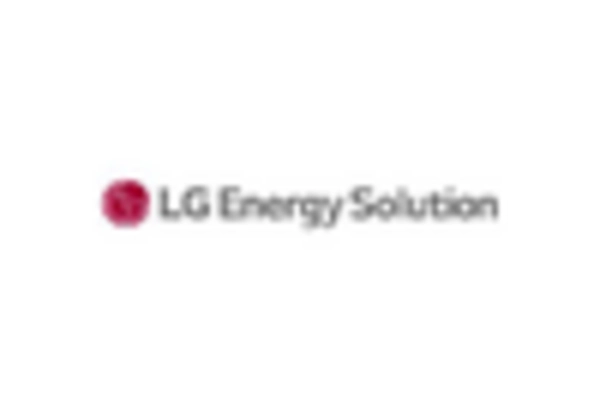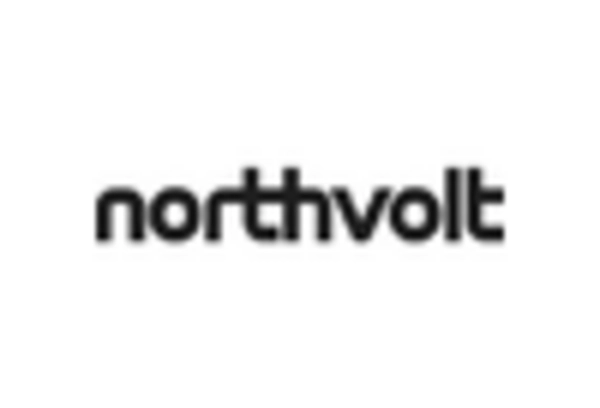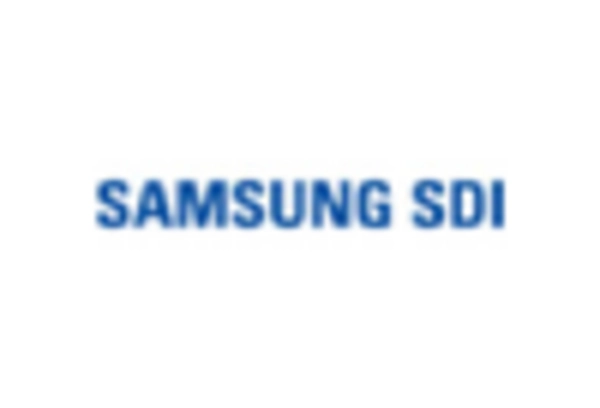Rising Demand for Electric Vehicles
The increasing consumer preference for electric vehicles (EVs) is a primary driver of the Europe Electric Vehicle Battery Market. As environmental awareness grows, more consumers are opting for EVs over traditional combustion engine vehicles. In 2025, it is estimated that EV sales in Europe will reach approximately 3 million units, reflecting a significant increase from previous years. This surge in demand necessitates a corresponding rise in battery production, thereby propelling the market forward. The shift towards EVs is further supported by advancements in battery technology, which enhance performance and reduce costs. Consequently, the Europe Electric Vehicle Battery Market is poised for substantial growth as manufacturers strive to meet the escalating demand for efficient and sustainable battery solutions.
Focus on Sustainability and Recycling
The emphasis on sustainability and recycling within the Europe Electric Vehicle Battery Market is becoming increasingly pronounced. As the market grows, so does the need for responsible sourcing of raw materials and effective recycling processes. In 2025, it is projected that the recycling rate for lithium-ion batteries will reach 50%, driven by regulatory pressures and consumer demand for sustainable practices. This focus on sustainability not only addresses environmental concerns but also reduces dependency on raw material imports, enhancing supply chain resilience. Consequently, the Europe Electric Vehicle Battery Market is likely to benefit from these initiatives, as manufacturers adopt sustainable practices to meet regulatory requirements and consumer expectations.
Investment in Charging Infrastructure
The expansion of charging infrastructure is a vital driver for the Europe Electric Vehicle Battery Market. As more consumers adopt electric vehicles, the availability of convenient and accessible charging stations becomes increasingly important. In 2025, it is anticipated that Europe will have over 1 million public charging points, a significant increase from previous years. This growth in infrastructure not only alleviates range anxiety among potential EV buyers but also encourages manufacturers to produce more electric vehicles, thereby boosting battery demand. The synergy between charging infrastructure development and battery production is crucial for the overall growth of the Europe Electric Vehicle Battery Market, as it creates a supportive ecosystem for electric mobility.
Government Regulations and Emission Standards
Stringent government regulations regarding emissions are a crucial factor influencing the Europe Electric Vehicle Battery Market. The European Union has implemented ambitious targets to reduce greenhouse gas emissions, aiming for a 55% reduction by 2030 compared to 1990 levels. These regulations compel automotive manufacturers to transition towards electric mobility, thereby increasing the demand for EV batteries. In 2025, it is projected that over 30% of new car sales in Europe will be electric, driven by these regulatory frameworks. As a result, the Europe Electric Vehicle Battery Market is likely to experience accelerated growth, as manufacturers align their production strategies with these evolving standards to remain competitive in the market.
Technological Innovations in Battery Production
Technological advancements in battery production are significantly shaping the Europe Electric Vehicle Battery Market. Innovations such as solid-state batteries and improved lithium-ion technologies are enhancing battery efficiency, longevity, and safety. In 2025, the market is expected to witness a shift towards these advanced battery technologies, which could potentially increase energy density by up to 50%. This improvement not only extends the driving range of electric vehicles but also reduces charging times, making EVs more appealing to consumers. As manufacturers invest in research and development to harness these technologies, the Europe Electric Vehicle Battery Market is likely to expand, driven by the demand for high-performance batteries that meet consumer expectations.


















Leave a Comment